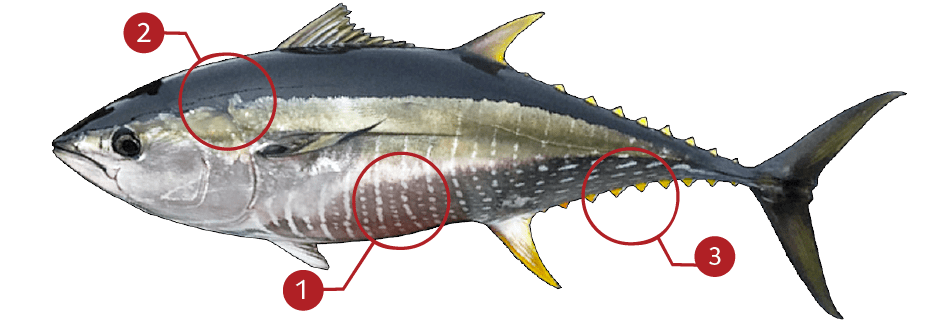YELLOWFIN TUNA
How to identify a Yellowfin Tuna
Most large yellowfins have overextended second dorsal and anal fins that may reach more than halfway back to the tail base in some large specimens. In smaller specimens under about 60 lb. (27 kg) and in some very large specimens as well, this may not be an accurate distinguishing factor since the fins do not appear to be as long as the specimens. The pectoral fins in adults reach to the origin of the second dorsal fin, but never beyond the second dorsal fin to the finlets as in the albacore. The bigeye tuna T. obesus and the blackfin tuna T. atlanticus may have pectoral fins similar in length to those of the yellowfin. The yellow fin can be distinguished from the blackfin by the black margins on the finlets. Blackfin tuna, like albacore, have white margins on the finlets. It can be distinguished from the bigeye tuna by the lack of striations on the ventral surface of the liver.This is probably the most colorful of all the tunas. The back is blue-black, fading to silver on the lower flanks and belly. A golden yellow or iridescent blue strip runs from the eye to the tail, though this is not always prominent. All the fins and finlets are golden yellow though in some very large specimens the elongated dorsal and anal fins may be silver edged with yellow. The finlets have black edges. The belly frequently shows as many as 20 vertical rows of whitish spots.
Where to catch Yellowfin Tuna
Occurs worldwide in deep, warm temperate oceanic waters. It is both pelagic and seasonally migratory, but has been known to come fairly close to come to shore.
IDENTIFICATION

| |
Belly frequently shows as many as 20 vertical rows of whitish spots |
| |
Back is blue-black, fading to silver on the lower flanks and belly, a golden yellow or iridescent blue strip runs from the eye to the tail |
| |
All the fins and finlets are golden yellow with some larger specimens may be silver-edged with yellow |
TARGET AREAS
|
|
Acknowledgements: We thank TAKEMEFISHING.org (www.takemefishing.org), Wisconsin Department of Natural Resources, Indiana Department of Natural Resources for their contributions to these FISH FACTS.

